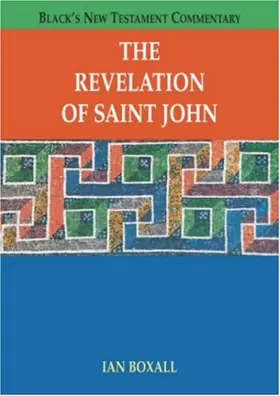

The Revelation of Saint John
in Black's New Testament Commentary
Pages
347
Publisher
Hendrickson
Published
2006
ISBN-13
9781565632028
Replacing George B. Caird's earlier volume, fellow Oxford scholar Ian Boxall's new edition in this popular series offers a clear and lucid study of St. John's apocalypse. Arising out of a critical awareness of the historical and theological issues surrounding the interpretation of Revelation, Boxall's exposition opens with an enlightening introduction to the first-century context of this difficult book. Introducing the background to the Apocalypse, Boxall leads the reader on a pericope-by-pericope exposition of the book. As with other volumes in the series, remarks are based on the author's own translation. Key terms and phrases from the translation are highlighted where they are discussed, while explanations of special Greek or foreign terms are provided. References to important primary and secondary literature are included for further research, and a Scripture index saves pastors and student valuable time.
Collections
This book appears in the following featured collections.
- Ultimate Commentary Collection: NT Expositional by John Glynn
- Nijay Gupta's Top NT Commentaries by Nijay K. Gupta
- Recommended New Testament Commentaries for Evangelical Pastors by Thomas R. Schreiner
- Commentaries by Roman Catholic Scholars by John Dyer
Reviews
Boxall's commentary is remarkably insightful and dense for a shorter work. His insight into the importance of Ezekiel to John's vision is helpful. It's one of the few commentaries where I wished the introduction was longer so he could explore some points more fully. Like any commentary, especially on Revelation, I can't say that I agreed with everything. But more often than not I felt he argued his points well and convincingly. One of the best non-technical works on Revelation I've read, extremely useful as I recently taught through Revelation.
[Full Review]
Written as a replacement for the 1966 Black’s commentary by G. B. Caird, no mean task, this compact volume aims to take account of subsequent developments—and much has happened since 1966. While my list would be different, Boxall mentions four such developments: a willingness to consider actual visionary experiences behind such accounts; attention to literary and structural aspects of the Apocalypse; the importance of the reception history of the work; and the importance of the author’s location on Patmos (xiv). The commentary is based on the author’s own translation, written for a popular audience and, like its predecessor, can be called a believer’s commentary. Like all such volumes, this one begins with an introduction to the issues of genre; author; date; audience, including their historical and social context; and the structure of the work. The conclusions are well-articulated if sometimes a little surprising. While the Apocalypse fits the “SBL definition” of an apocalypse, that is an “insufficient” designation because of its prophetic character (1–2) and also because account must be taken of its form as a letter (3). This leads to a short discussion of whether these are reports of “actual visionary experiences” or “a literary fiction” (3–4). While Boxall leaves room for conscious reflection and crafting, these are actual visions. This leads to the surprising conclusion that John’s “conscious intention cannot be the determining factor” in establishing meaning (5). It may mean more than John knew.
[Full Review]



